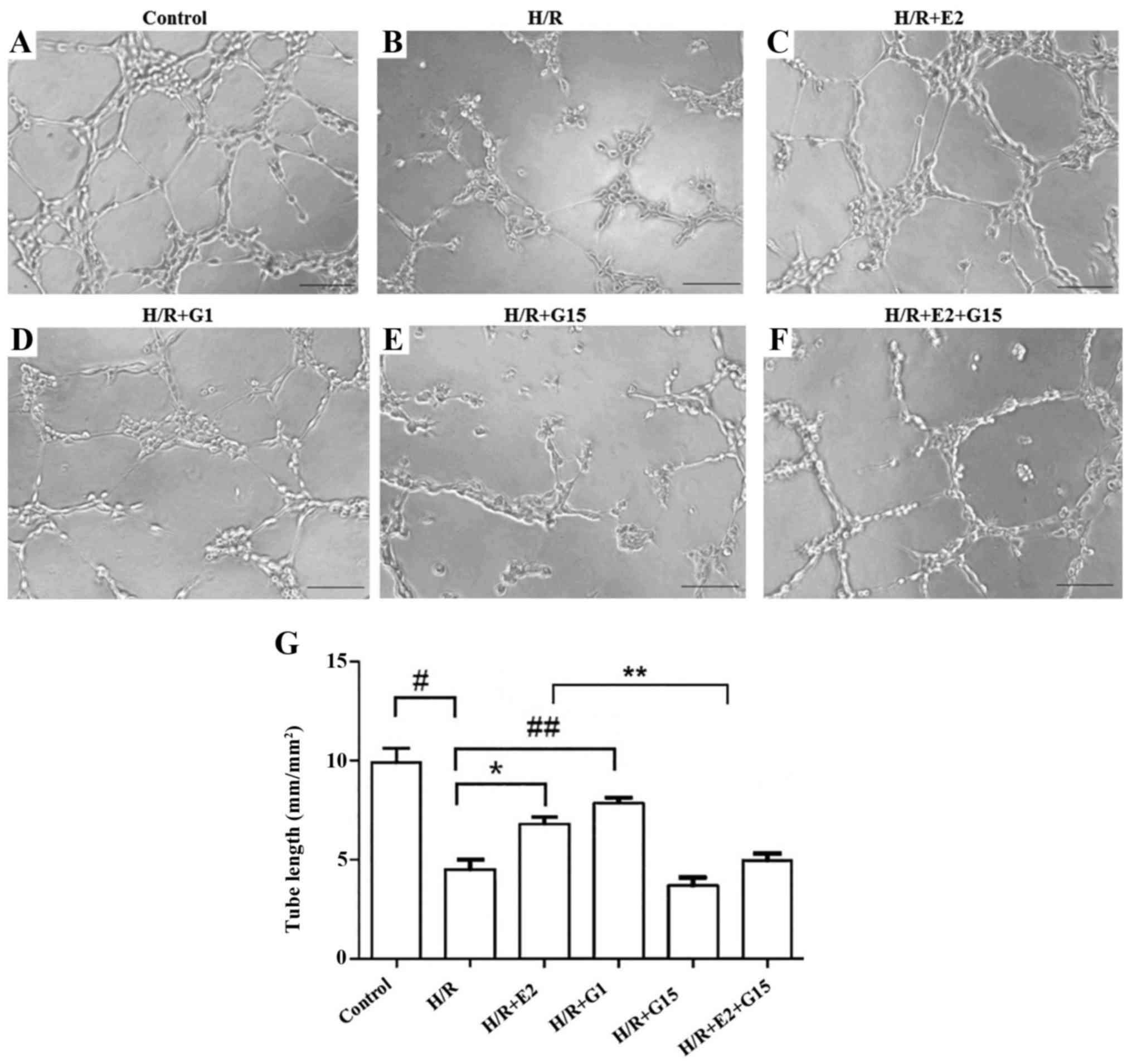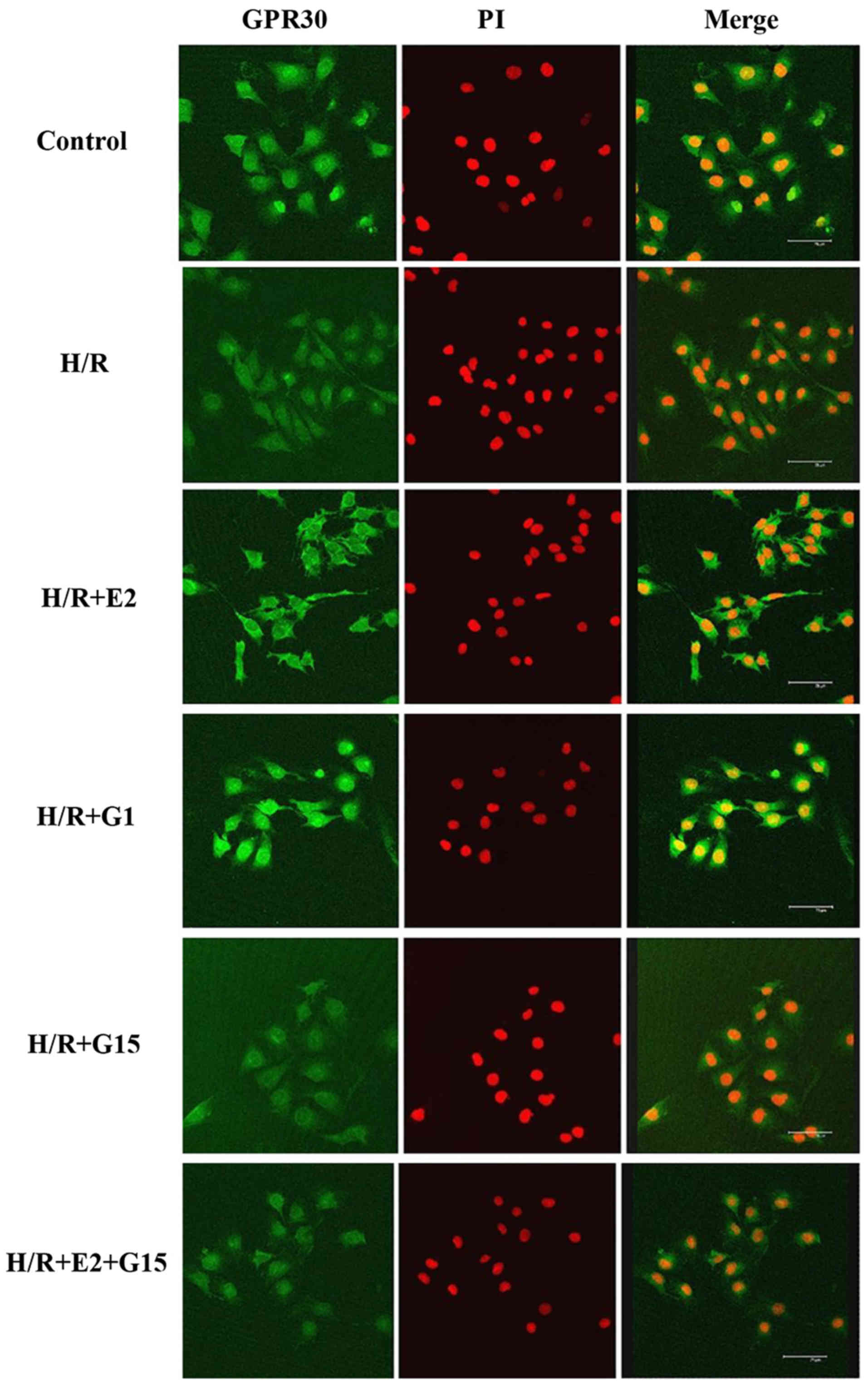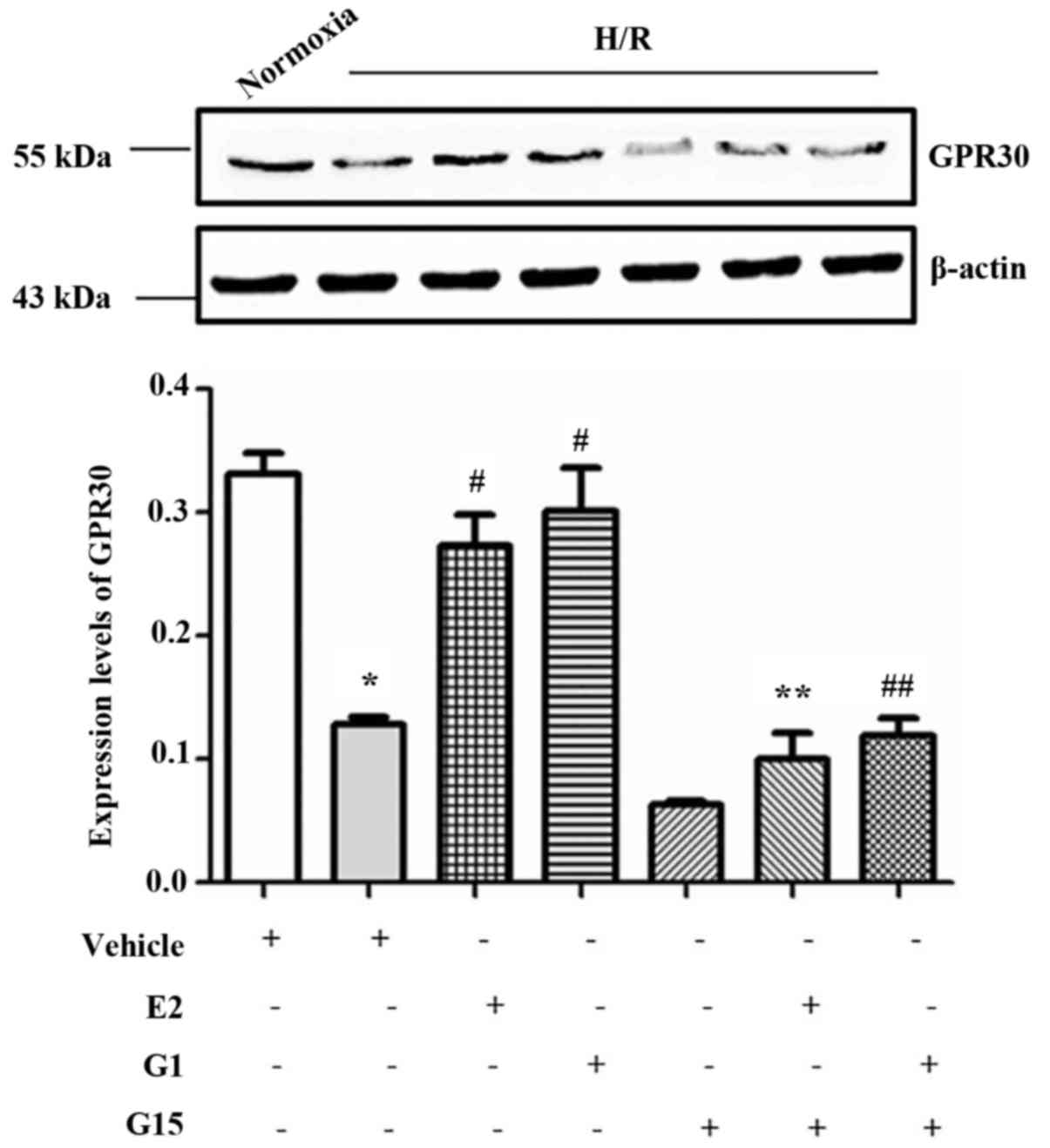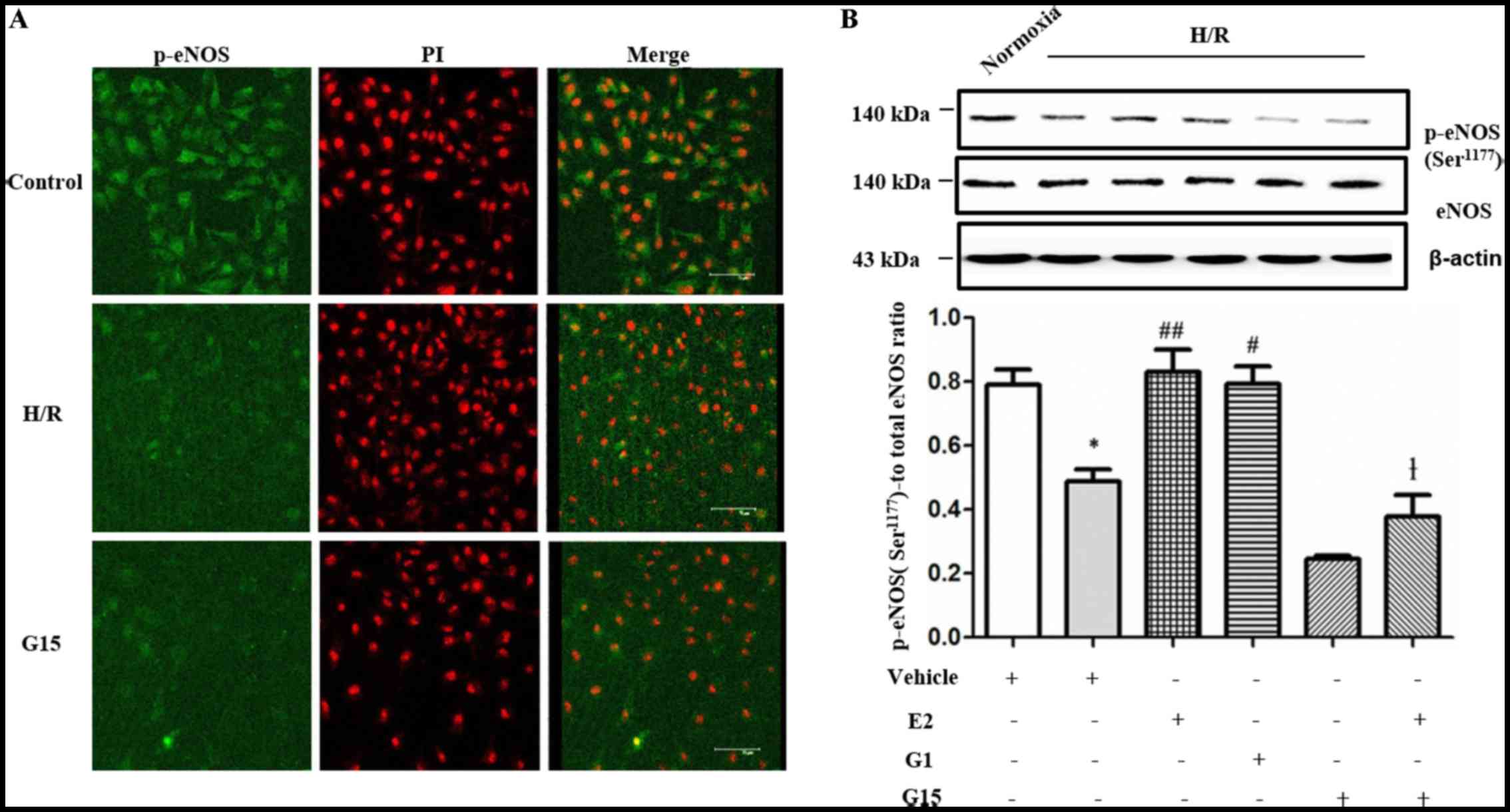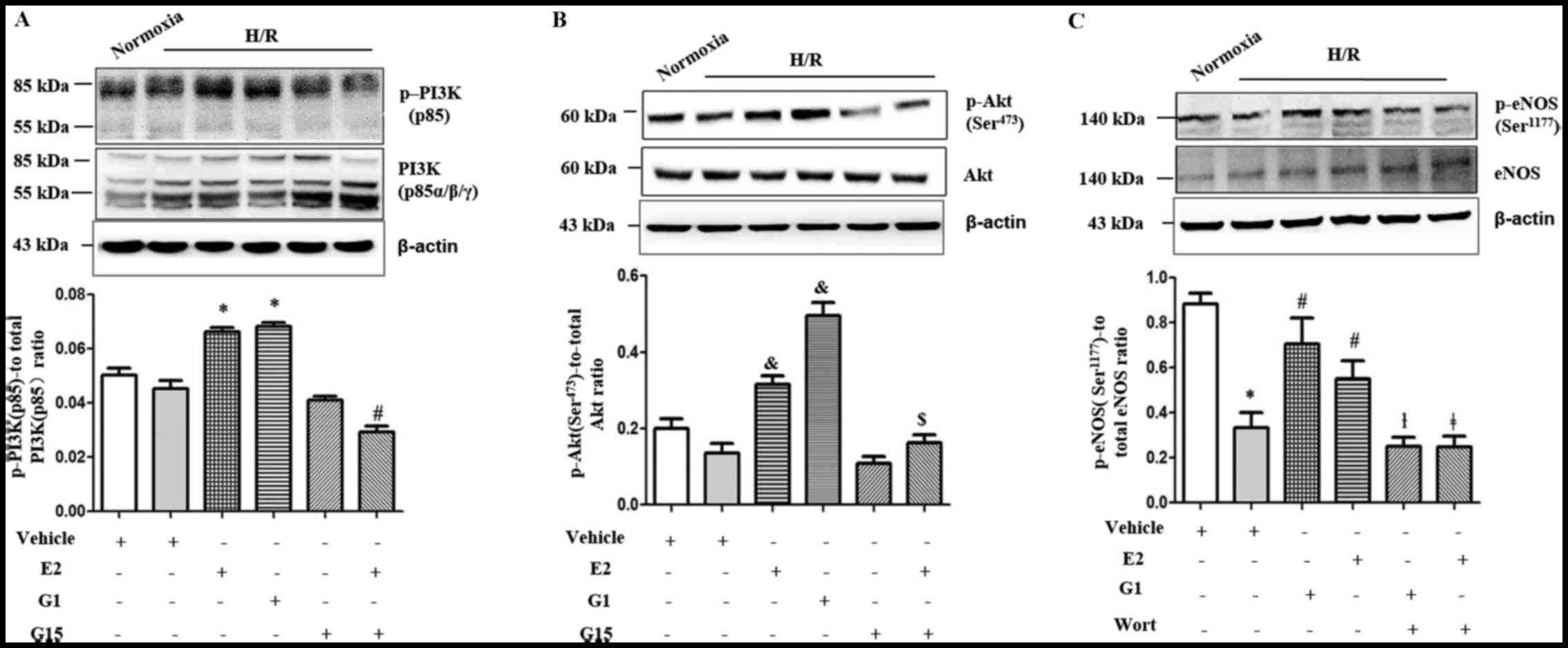G-protein-coupled receptor 30 mediates the effects of estrogen on endothelial cell tube formation in vitro
- Authors:
- Published online on: April 20, 2017 https://doi.org/10.3892/ijmm.2017.2957
- Pages: 1461-1467
-
Copyright: © Zhou et al. This is an open access article distributed under the terms of Creative Commons Attribution License.
Abstract
Introduction
Successful pregnancy requires normal placental function from adequate placentation and placental vascularization. It may increase proportionally to the organ volume to maintain the number of placental vessels throughout the gestation. Therefore, the study of placental vascularization can enhance our understanding of the physiopathological process of increased resistance in umbilical arteries associated with placental insufficiency. Abnormal placentation causes inadequate utero-placental blood flow (1), resulting in a number of pregnancy complications, including preeclampsia, a leading cause of maternal and perinatal mortality and morbidity (2), and intrauterine growth restriction (IUGR) (3,4).
During normal pregnancy, women experience changes in hormone levels. The levels of both estrogen and progesterone are increased during pregnancy. The blocking of estrogen production results in pregnancy loss in animal models, suggesting that estrogen plays a role in the maintenance of healthy pregnancy. It has been suggested that in addition to its anti-inflammatory effect (5), estrogen also stimulates endothelial cell function and angiogenesis, in particular in vessel formation [reviewed in (6)]. There is growing evidence to suggest that lower levels of estrogen and an increase in progesterone are associated with the pathogenesis of preeclampsia (7–9). However, whether estrogen plays an important role in the regulation of vascular growth in the placenta during pregnancy has not yet been fully investigated.
The biological effects of estrogen are usually mediated by estrogen receptors (ERs)α and β (10,11). However, previous studies have suggested that mediating the function of estrogen can be achieved not only through ERα and ERβ. G-protein-coupled receptor 30 (GPR30), identified as a novel estrogen receptor in 2005 has been suggested to mediate the action of estrogen (12,13). Recently, we also reported that GPR30 is involved in the development of preeclampsia (14,15). GPR30 is a specific receptor for 17β-estradiol, a form of estrogens (16), and is expressed in endothelial cells. It is a regulator of the inflammatory response in endothelial cells (5).
Abnormal placentation causes placental ischemia and hypoxia, and it is well known that hypoxia/reoxygenation (H/R) may be a potential mechanism which contributes to the development of preeclampsia (17). Therefore, we undertook this in vitro study to investigate the effects of estrogen on endothelial cell tube formation, as well as the potential mechanisms responsible for these effects.
Materials and methods
Reagents
17-β-estradiol (E2; ab120657), a general ER agonist, and monoclonal anti-GPR30 (ab154069) antibody were purchased from Abcam (Cambridge, MA, USA). The selective GPR30 agonist, G1, the selective GPR30 inhibitor, G15, and the specific PI3K inhibitor, wortmannin, were purchased from Sigma-Aldrich, St. Louis, MO, USA (G6798, G6748 and W1628, respectively). Anti-endothelial nitric oxide synthase (eNOS; Cat. no. 5880), monoclonal anti-phosphorylated (p-)PI3K (p85; Cat. no. 4228), monoclonal anti-p-eNOS Ser1177 (Cat. no. 9570) and monoclonal anti-p-Akt (p-Akt Ser473; Cat. no. 4060) antibodies were purchased from Cell Signaling Technology Inc. (Danvers, MA, USA).
Cell culture under H/R conditions
Human umbilical vein endothelial cells (HUVECs) were purchased from Biomics Biotechnologies Co., Ltd. (Nantong, China) and cultured in Medium-1640 (Gibco Life Technologies, Beijing, China) with 10% (v/v) fetal bovine serum (FBS) (Gibco Life Technologies) at 37°C in 5% CO2 in air. The HUVECs were seeded and grown to 80% confluence under H/R conditions, as previously described (18–21). In brief, to decrease the influence of stimulation by serum mitogens, the HUVECs were incubated for 12 h in low-serum medium which was supplemented with 1% FBS prior to exposure to H/R. The HUVECs were then incubated in a hypoxic environment (5% CO2, 94% N2 and 1% O2) in a tri-gas cell culture incubator (Thermo Fisher Scientific Oxoid, Ltd., Basingstoke, UK) for 4 h, and subsequently moved to a normoxic incubator with 5% CO2 in air with normal culture medium (10% FBS) for a further 18 h. The oxygen concentration inside the tri-gas incubator was monitored by an oxygen analyser (Vascular Technology Inc., Nashua, NH, USA).
In some experiments, the HUVECs were individually pre-treated with 17-β-estradiol (E2) (100 nM) or G1 (1 mM) or G15 (2 mM) for 1 h (5,22), and then exposed to 4 h of hypoxia followed by 18 h of reoxygenation.
Immunofluorescence
The immunofluorescence staining of GPR30 and p-eNOS in the HUVECs was performed as previously described (23). Following treatment, the HUVECs were fixed in 4% formaldehyde (Aladdin, Shanghai, China) and blocked with 10% normal goat serum (Sigma-Aldrich), then incubated with anti-GPR30 antibody (1:80 dilution) or anti-p-eNOS Ser1177 antibody (1:25 dilution). A fluorescein isothiocyanate-conjugated goat anti-rabbit antibody (1:50 dilution; sc-2012; Santa Cruz Biotechnology, Inc., Santa Cruz, CA, USA) was then used. The nuclei were stained with propidium iodide (3 mg/ml; Santa Cruz Biotechnology, Inc.). Images were acquired using a confocal microscope (FV10i; Olympus Corp., Tokyo, Japan).
Western blot analysis
The relative activation levels of eNOS and Akt in the HUVECs following treatment were measured by western blot analysis as described (18,24). Briefly, the HUVECs were homogenised in RIPA buffer (50 mM Tris, 150 mM NaCl, 1% sodium deoxycholate, 0.1% SDS, 1% Nonident P40 substitute, protease inhibitor, 1 mM phenylmethanesulfonylfluoride). All the samples (10 µl) were loaded on 6–10% SDS-PAGE gels and electrophoresed then transferred onto nitrocellulose membranes. Non-specific binding was blocked by incubating membranes in 5% non-fat milk for 1 h and the membranes were then incubated with monoclonal anti-GPR30 (1:1,000 dilution) or monoclonal anti-p-PI3K (p85) (1:500 dilution) or polyclonal anti-PI3K (p85) (1:500 dilution; sc-292114; Santa Cruz Biotechnology, Inc.) or monoclonal anti-p-Akt (p-Akt Ser473) (1:1,000 dilution) or polyclonal anti-Akt (1:500 dilution; sc-5298; Santa Cruz Biotechnology, Inc.) or monoclonal anti-p-eNOS (Ser1177) (1:1,000 dilution) or monoclonal anti-eNOS (1:1,000 dilution) antibodies. After washing with PBS-T, the membranes were incubated with goat anti-mouse (1:2,000 dilution; ZB-2305; ZSGB-BIO, Beijing, China) or goat anti-rabbit (1:2,000 dilution; ZB-2301; ZSGB-BIO) secondary antibodies for 1 h at room temperature. After washing with PBS-T, the membranes were then incubated with streptavidin-conjugated horseradish peroxidase (1:3,000) for 1 h at room temperature. After washing with (PBS-T), the membranes were incubated with Amersham™ ECL™ Prime Western blotting detection reagent. β-actin (1:500 dilution; A1978; Sigma-Aldrich) was used as a loading control.
In vitro tube formation assay
The in vitro tube formation assay in the HUVECs was performed as previously described (18,25). Matrigel (BD Biosciences, Franklin Lakes, NJ, USA) was thawed at 4°C overnight and then diluted with serum-free medium at a ratio of 1:2; the mixture was distributed into a 96-well plate (65 µl/well) and incubated at 37°C for 2 h. The HUVECs (1.0×104), subjected to a variety of pre-treatments, were added to wells in triplicate under H/R conditions (hypoxia for 4 h and reoxygenation for 18 h) or culture in normal oxygen for 22 h. Following treatment, the cultures were captured from each well using a microscope (Olympus Corp.) (5 for each, ×100 magnification). The total pipe length of the tube-like structure was calculated by using image-Pro Plus software (version 6.0; NIH image). Tracks of HUVECs organised into networks of cellular cords were counted and averaged in 5 randomly selected view fields (×100 magnification). The tube formation indexes were expressed as tube length (mm)/mm2 area.
Statistical analysis
All the experiments in this study were performed at least 3 times and the data are expressed as the means ± standard deviation (SD). Statistical analyses were performed using Graph Pad Prism 5.0 (GraphPad Software Inc., La Jolla, CA, USA). Differences between 2 groups were analysed by independent t-test assuming, while differences between multi-groups were analysed by one-way ANOVA. A value of P<0.05 was considered to indicate a statistically significant difference.
Results
A previous study suggested that estrogen has an effect on endothelial cell angiogenesis (6). In this study, to further investigate the effects of estrogen on endothelial cell tube formation, the total pipe length of the tube-like structure in HUVECs that had been treated with 17-β-estradiol (E2) or the selective GPR30 agonist, G1, was measured after 22 h of culture under H/R conditions (Fig. 1A–F). The total pipe length of the tube-like structure in the HUVECs that had been cultured under H/R conditions was significantly reduced compared to the HUVECs that were cultured under normoxic control conditions (Fig. 1G; P=0.003). This reduction was reversed by pre-treatment with 17-β-estradiol (E2) (Fig. 1G; P=0.017) or G1 (Fig. 1G; P=0.003). However, the protective effects of 17-β-estradiol (E2) on tube formation were inhibited by G15 (Fig. 1G; P=0.021).
In order to investigate whether GPR30, one of the estrogen receptors, is involved in the protective effects of 17-β-estradiol (E2) on endothelial cell tube formation, GPR30 expression in HUVECs was measured in the presence or absence of 17-β-estradiol (E2) or G1 in culture under H/R conditions. The expression of GPR30 was significantly decreased under H/R conditions compared with that under normoxic conditions (Fig. 2). However, this reduction of GPR30 expression in the HUVECs induced by H/R conditions was significantly reversed when the cells were pre-treated with 17-β-estradiol (E2) or G1 (Fig. 2). Howeveer, the effects of 17-β-estradiol (E2) and G1 were inhibited by treatment with the specific GPR30 inhibitor, G15 (Fig. 2). The decrease in GPR30 expression in the HUVECs was also confirmed by western blot analysis (Fig. 3; P<0.001).
It has previously been suggested that GPR30 activates eNOS. The activation of eNOS is involved in angiogenesis (26–28). In this study, we further investigated whether eNOS is involved in tube formation of endothelial cells in vitro under H/R conditions. Immunofluorescence revealed that the levels of p-eNOS (Ser1177) in the HUVECs were decreased under H/R conditions and following treatment with G15 compared with the control group (Fig. 4A). The decrease in the expression of p-eNOS at Ser1177 in the HUVECs under H/R conditions was also confirmed by western blot analysis (Fig. 4B; P=0.0132). However, the decrease in p-eNOS expression was reversed by pre-treatment with 17-β-estradiol (E2) (Fig. 4B; P=0.0052) or the selective GPR30 agonist, G1 (Fig. 4B; P=0.0123). However, the effects of 17-β-estradiol (E2) were inhibited by treatment with G15 (Fig. 4B; P=0.0005).
We further investigated the estrogen-mediated phosphorylation of PI3K (p85) and Akt (Ser473) in the HUVECs under H/R conditions. The expression of p-PI3K (p85) and p-Akt (Ser473) in the HUVECs was significantly increased by pre-treatment with either G1 (Fig. 5A and B; P=0.0001 and P=0.0027, respectively) or 17-β-estradiol (E2) (Fig. 5A and B; P=0.0001). This effect of 17-β-estradiol (E2) was inhibited by treatment with G15 (Fig. 5A and B; P<0.0001 and P=0.0098).
We then investigated whether the PI3K/Akt signalling pathway mediates GPR30-dependent eNOS activation in HUVECs under H/R conditions. The effects of 17-β-estradiol (E2) and G1 on eNOS phosphorylation in the HUVECs were blocked by the PI3K inhibitor, wortmannin (Wort, 100 nM) (Fig. 5C; P<0.0001).
Discussion
During human pregnancy, the placenta is supplied with maternal blood via the uterine spiral arteries. The fetus requires an increasing supply of oxygen and nutrients, suggesting that uterine spiral artery remodelling is necessary for a successful pregnancy. However, the failure of spiral artery remodelling impacts the oxygen concentration analogous to hypoxia-reperfusion within the placental environment. A decreased feto-placental perfusion and restricted oxygen delivery causes placental insufficiency, resulting in a number of complications of pregnancy, such as preeclampsia and IUGR. H/R is a secondary to intermittent perfusion of the intervillous space and plays an important role in placental development (17). Studies have suggested that H/R causes apoptotic changes in syncytiotrophoblasts, which is another characteristic feature of the preeclamptic placenta (29,30). During normal pregnancy, women experience changes in hormone levels and the levels of both estrogen and progesterone are increased. Lower levels of estrogen have been reported in women with preeclampsia (7–9). However, whether estrogen has an effect on placental vasculature is unknown.
Placental vasculature expands in both maternal and fetal placental tissue during pregnancy (31). Endothelial cell tube formation assay is a common tool to study angiogenesis. In this in vitro study, we found that the supplementation of 17-β-estradiol (E2), a form of estrogen reversed the failure of endothelial cell tube formation induced by H/R. Another study demonstrated that estrogen, such as 17-β-estradiol (E2) plays a role in the modulation of endothelial cell function and in the promotion of angiogenesis (6). That study also suggested that the effect of 17-β-estradiol (E2) on angiogenesis may also apply to in vivo (6). A recent study further suggested that 17-β-estradiol (E2) was able to protect cardiomyocytes against H/R injury (32). To understand the specific mechanisms of estrogen by which receptors improve endothelial cell tube formation, in this in vitro study, we found that the expression of GPR30, a novel estrogen receptor was significantly reduced in endothelial cells under H/R conditions. However, this decreased expression of GPR30 was reversed by the supplementation of 17-β-estradiol (E2) or a selective GPR30 agonist (G1) in endothelial cells under H/R conditions. GPR30 is associated with the protective effects of estrogen in breast cancer (12,13). A recent study also suggested that the GPR30 agonist, G1, improves cerebral microvascular function following H/R injury in animal model (33). Taken together, our data suggest that 17-β-estradiol (E2) may have a similar function as the GPR30 agonist, G1. 17-β-estradiol (E2) is involved in the regulation of endothelial cell tube formation in H/R injury and its protective effects are associated with estrogen receptor, GPR30, in endothelial cells.
Reactive oxygen species (ROS) play an important role in endothelial cell dysfunction (34) and multiple ROS systems are activated during H/R, including NOS (35). A number of studies have suggested that the activation of eNOS is involved in angiogenesis (26,36). Endogenous estrogens mediate protective effects at least partially due to the activation of eNOS and the bioactivity of NO is regulated by GPR30 in the cardiovascular system. In addition, the protective effects of the GPR30 agonist, G1, in endothelial cells following H/R injury, at least partially also depends on eNOS (33). In this in vitro study, consistent with other studies, we found that the decreased expression of eNOS induced by H/R was reversed by the addition of 17-β-estradiol (E2) or the GPR30 agonist, G1, in endothelial cell culture.
A previous study suggested that in addition to the association with the expression of eNOS, GPR30 also mediated the activation of Akt in endothelial cells (37) and is involved in cell proliferation (38). In this in vitro study, we also found that the expression of Akt was decreased by H/R in endothelial cells; however, this decrease in Akt expression was reversed by supplementation with either 17-β-estradiol (E2) or the GPR30 agonist, G1. We further found that the activation of eNOS induced by 17-β-estradiol (E2) or the GPR30 agonist, G1, was inhibited by an inhibitor of PI3K/Akt (wortmannin), suggesting the activation of eNOS induced by 17-β-estradiol (E2) is Akt-dependent in endothelial cells under H/R conditions. Taken together our data suggest that both eNOS and PI3K/Akt activation are involved in the prevention of endothelial cell tube formation by 17-β-estradiol (E2), and the PI3K/Akt signalling pathway regulates the activation of eNOS in the prevention of endothelial cell tube formation by 17-β-estradiol (E2).
In conclusion, to the best of our knowledge, in the present in vitro study, we report for the first time that the supplementation of estrogen 17-β-estradiol (E2) may prevent the failure of endothelial cell tube formation induced by H/R. The estrogen receptor, GPR30, is at least partially involved in this protective effect through the activation of eNOS and the Akt signalling pathway in endothelial cells. Lower levels of estrogen are reported in complications of pregnancy, such as preeclampsia. Therefore, our data suggest that increased levels of estrogen during normal pregnancy promote placental vasculature development, thus exerting positive effects.
Acknowledgments
This study was supported by the National Natural Science Foundation of China (nos. 81370732 and 81571453).
References
|
Khong Y and Brosens I: Defective deep placentation. Best Pract Res Clin Obstet Gynaecol. 25:301–311. 2011. View Article : Google Scholar | |
|
Sibai B, Dekker G and Kupferminc M: Preeclampsia. Lancet. 365:785–799. 2005. View Article : Google Scholar : PubMed/NCBI | |
|
Roberts JM and Hubel CA: Is oxidative stress the link in the two-stage model of preeclampsia? Lancet. 354:788–789. 1999. View Article : Google Scholar : PubMed/NCBI | |
|
Hubel CA: Oxidative stress in the pathogenesis of preeclampsia. Proc Soc Exp Biol Med. 222:222–235. 1999. View Article : Google Scholar : PubMed/NCBI | |
|
Chakrabarti S and Davidge ST: G-protein coupled receptor 30 (GPR30): A novel regulator of endothelial inflammation. PLoS One. 7:e523572012. View Article : Google Scholar | |
|
Rubanyi GM, Johns A and Kauser K: Effect of estrogen on endothelial function and angiogenesis. Vascul Pharmacol. 38:89–98. 2002. View Article : Google Scholar : PubMed/NCBI | |
|
Zeisler H, Jirecek S, Hohlagschwandtner M, Knöfler M, Tempfer C and Livingston JC: Concentrations of estrogens in patients with preeclampsia. Wien Klin Wochenschr. 114:458–461. 2002.PubMed/NCBI | |
|
Tamimi R, Lagiou P, Vatten LJ, Mucci L, Trichopoulos D, Hellerstein S, Ekbom A, Adami HO and Hsieh CC: Pregnancy hormones, preeclampsia, and implications for breast cancer risk in the offspring. Cancer Epidemiol Biomarkers Prev. 12:647–650. 2003.PubMed/NCBI | |
|
Jobe SO, Tyler CT and Magness RR: Aberrant synthesis, metabolism, and plasma accumulation of circulating estrogens and estrogen metabolites in preeclampsia implications for vascular dysfunction. Hypertension. 61:480–487. 2013. View Article : Google Scholar : PubMed/NCBI | |
|
Molvarec A, Vér A, Fekete A, Rosta K, Derzbach L, Derzsy Z, Karádi I and Rigó J Jr: Association between estrogen receptor alpha (ESR1) gene polymorphisms and severe preeclampsia. Hypertens Res. 30:205–211. 2007. View Article : Google Scholar : PubMed/NCBI | |
|
Maruyama A, Nakayama T, Sato N, Mizutani Y, Furuya K and Yamamoto T: Association study using single nucleotide polymorphisms in the estrogen receptor beta (ESR2) gene for preeclampsia. Hypertens Res. 27:903–909. 2004. View Article : Google Scholar | |
|
Thomas P, Pang Y, Filardo EJ and Dong J: Identity of an estrogen membrane receptor coupled to a G protein in human breast cancer cells. Endocrinology. 146:624–632. 2005. View Article : Google Scholar | |
|
Revankar CM, Cimino DF, Sklar LA, Arterburn JB and Prossnitz ER: A transmembrane intracellular estrogen receptor mediates rapid cell signaling. Science. 307:1625–1630. 2005. View Article : Google Scholar : PubMed/NCBI | |
|
Tong C, Feng X, Chen J, Qi X, Zhou L, Shi S, Kc K, Stanley JL, Baker PN and Zhang H: G protein-coupled receptor 30 regulates trophoblast invasion and its deficiency is associated with preeclampsia. J Hypertens. 34:710–718. 2016. View Article : Google Scholar : PubMed/NCBI | |
|
Li J, Chen Z, Zhou X, Shi S, Qi H, Baker PN and Zhang H: Imbalance between proliferation and apoptosis-related impaired GPR30 expression is involved in preeclampsia. Cell Tissue Res. 366:499–508. 2016. View Article : Google Scholar : PubMed/NCBI | |
|
Prossnitz ER, Arterburn JB and Sklar LA: GPR30: A G protein-coupled receptor for estrogen. Mol Cell Endocrinol. 265–266:138–142. 2007. View Article : Google Scholar | |
|
Hung TH, Skepper JN, Charnock-Jones DS and Burton GJ: Hypoxia-reoxygenation: A potent inducer of apoptotic changes in the human placenta and possible etiological factor in preeclampsia. Circ Res. 90:1274–1281. 2002. View Article : Google Scholar : PubMed/NCBI | |
|
Luo X, Yao ZW, Qi HB, Liu DD, Chen GQ, Huang S and Li QS: Gadd45α as an upstream signaling molecule of p38 MAPK triggers oxidative stress-induced sFlt-1 and sEng upregulation in preeclampsia. Cell Tissue Res. 344:551–565. 2011. View Article : Google Scholar : PubMed/NCBI | |
|
Dhar-Mascareño M, Cárcamo JM and Golde DW: Hypoxia-reoxygenation-induced mitochondrial damage and apoptosis in human endothelial cells are inhibited by vitamin C. Free Radic Biol Med. 38:1311–1322. 2005. View Article : Google Scholar : PubMed/NCBI | |
|
Lee SR and Lo EH: Interactions between p38 mitogen-activated protein kinase and caspase-3 in cerebral endothelial cell death after hypoxia-reoxygenation. Stroke. 34:2704–2709. 2003. View Article : Google Scholar : PubMed/NCBI | |
|
Lee SR and Lo EH: Induction of caspase-mediated cell death by matrix metalloproteinases in cerebral endothelial cells after hypoxia-reoxygenation. J Cereb Blood Flow Metab. 24:720–727. 2004. View Article : Google Scholar : PubMed/NCBI | |
|
Tian R, Wang Z, Shi Z, Li D, Wang Y, Zhu Y, Lin W, Gui Y and Zheng XL: Differential expression of G-protein-coupled estrogen receptor-30 in human myometrial and uterine leiomyoma smooth muscle. Fertil Steril. 99:256–263. 2013. View Article : Google Scholar | |
|
Otto C, Rohde-Schulz B, Schwarz G, Fuchs I, Klewer M, Brittain D, Langer G, Bader B, Prelle K, Nubbemeyer R, et al: G protein-coupled receptor 30 localizes to the endoplasmic reticulum and is not activated by estradiol. Endocrinology. 149:4846–4856. 2008. View Article : Google Scholar : PubMed/NCBI | |
|
Yang Z, Bai B, Luo X, Xiao X, Liu X, Ding Y, Zhang H, Gao L, Li J and Qi H: Downregulated Krüppel-like factor 8 is involved in decreased trophoblast invasion under hypoxia-reoxygenation conditions. Reprod Sci. 21:72–81. 2014. View Article : Google Scholar : | |
|
Marconcini L, Marchiò S, Morbidelli L, Cartocci E, Albini A, Ziche M, Bussolino F and Oliviero S: c-fos-induced growth factor/vascular endothelial growth factor D induces angiogenesis in vivo and in vitro. Proc Natl Acad Sci USA. 96:9671–9676. 1999. View Article : Google Scholar : PubMed/NCBI | |
|
Kim KM, Kim NS, Kim J, Park JS, Yi JM, Lee J and Bang OS: Magnolol suppresses vascular endothelial growth factor-induced angiogenesis by inhibiting Ras-dependent mitogen-activated protein kinase and phosphatidylinositol 3-kinase/Akt signaling pathways. Nutr Cancer. 65:1245–1253. 2013. View Article : Google Scholar : PubMed/NCBI | |
|
Batenburg WW, Jansen PM, van den Bogaerdt AJ and J Danser AH: Angiotensin II-aldosterone interaction in human coronary microarteries involves GPR30, EGFR, and endothelial NO synthase. Cardiovasc Res. 94:136–143. 2012. View Article : Google Scholar : PubMed/NCBI | |
|
Li ZL, Liu JC, Liu SB, Li XQ, Yi DH and Zhao MG: Improvement of vascular function by acute and chronic treatment with the GPR30 agonist G1 in experimental diabetes mellitus. PLoS One. 7:e387872012. View Article : Google Scholar : PubMed/NCBI | |
|
Redman CW and Sargent IL: Placental debris, oxidative stress and preeclampsia. Placenta. 21:597–602. 2000. View Article : Google Scholar : PubMed/NCBI | |
|
Allaire AD, Ballenger KA, Wells SR, McMahon MJ and Lessey BA: Placental apoptosis in preeclampsia. Obstet Gynecol. 96:271–276. 2000.PubMed/NCBI | |
|
Burton GJ, Charnock-Jones DS and Jauniaux E: Regulation of vascular growth and function in the human placenta. Reproduction. 138:895–902. 2009. View Article : Google Scholar : PubMed/NCBI | |
|
Cong B, Xu Y, Sheng H, Zhu X, Wang L, Zhao W, Tang Z, Lu J and Ni X: Cardioprotection of 17β-estradiol against hypoxia/reoxygenation in cardiomyocytes is partly through up-regulation of CRH receptor type 2. Mol Cell Endocrinol. 382:17–25. 2014. View Article : Google Scholar | |
|
Murata T, Dietrich HH, Xiang C and Dacey RG Jr: G protein-coupled estrogen receptor agonist improves cerebral microvascular function after hypoxia/reoxygenation injury in male and female rats. Stroke. 44:779–785. 2013. View Article : Google Scholar : PubMed/NCBI | |
|
Granger DN, Kvietys PR and Perry MA: Leukocyte - endothelial cell adhesion induced by ischemia and reperfusion. Can J Physiol Pharmacol. 71:67–75. 1993. View Article : Google Scholar : PubMed/NCBI | |
|
Zulueta JJ, Sawhney R, Yu FS, Cote CC and Hassoun PM: Intracellular generation of reactive oxygen species in endothelial cells exposed to anoxia-reoxygenation. Am J Physiol. 272:L897–L902. 1997.PubMed/NCBI | |
|
Song Y, Zhao XP, Song K and Shang ZJ: Ephrin-A1 is up-regulated by hypoxia in cancer cells and promotes angiogenesis of HUVECs through a coordinated cross-talk with eNOS. PLoS One. 8:e744642013. View Article : Google Scholar : PubMed/NCBI | |
|
Rowlands DJ, Chapple S, Siow RC and Mann GE: Equol-stimulated mitochondrial reactive oxygen species activate endothelial nitric oxide synthase and redox signaling in endothelial cells: Roles for F-actin and GPR30. Hypertension. 57:833–840. 2011. View Article : Google Scholar : PubMed/NCBI | |
|
Kolkova Z, Casslén V, Henic E, Ahmadi S, Ehinger A, Jirström K and Casslén B: The G protein-coupled estrogen receptor 1 (GPER/GPR30) does not predict survival in patients with ovarian cancer. J Ovarian Res. 5:92012. View Article : Google Scholar : PubMed/NCBI |



